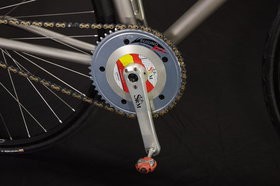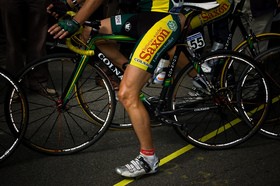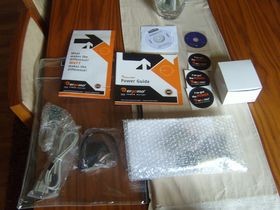 Bicycle power meters are the new rage for triathletes.
Bicycle power meters are the new rage for triathletes.
The Internet is brimming with articles, videos, and testimonials raving about the benefits of using a power meter. So now you’re wondering if you should get one.
Consider this a crash course on power meters to help you determine if a power meter could help you in your training as a triathlete.
What Are Bike Power Meters?
What is a power meter and why is it helpful?
A cycling power meter is a device put on a bicycle that allows the measurement of the power output of the rider.
In a nutshell: Power = force times distance/time, which is expressed in watts.
Most cycling power meters use strain gauges, which are mounted in the bottom bracket, rear freehub, or crankset of your bike. Newer versions do not use strain gauges and instead measure power through handlebar-mounted units that utilize the principles of Newton’s Third Law by measuring a cyclist’s opposing forces (gravity, wind resistance, inertia, rolling resistance) and combining these with velocity to determine the rider’s power output.
Power Meter vs Heart Rate Monitor
Power meters provide instant feedback to the rider about their performance and measure their actual output. For example, a triathlete using a power meter can instantly see that they are producing 350 watts, instead of waiting for their heart rate to climb to a certain point.
Power meters also provide an objective measurement of real output that allows training progress to be tracked very simply — something that is more difficult when using a heart rate monitor alone.
Power meters measure the force that moves the bike forward multiplied by the velocity, which is the desired goal. This has 2 significant advantages over heart rate monitors:
1) A triathlete’s heart rate could remain constant over the duration of a training session, yet their power output be declining, which they could not detect with a heart rate monitor; and
2) While a triathlete who is not rested or not feeling entirely well may train at their normal heart rate, they are unlikely to be producing their normal power. A heart rate monitor will not reveal this, but a power meter will.
Power meters allow the rider to experiment with cadence and evaluate its effect relative to speed and heart rate.
The Importance of Cycling Speed for Triathletes
 The power produced by a cyclist is used to overcome aerodynamic, inertial, rolling resistance, gravitational, and miscellaneous drivetrain/bearing forces.
The power produced by a cyclist is used to overcome aerodynamic, inertial, rolling resistance, gravitational, and miscellaneous drivetrain/bearing forces.
Cycling speed is fundamentally bound by how much power one can produce. Regardless of the distance of any given triathlon, the cycling portion is the longest. Logic tells you that improvement in the area of cycling is where you will get the biggest bang for your buck in terms of improving your overall triathlon performance.
How many minutes could you shave off of your biking split if you trained to increase your power?
Pacing Yourself With A Power Meter
The power meter can also help you pace the bike leg appropriately.
If you have trained to race at 350 watts, and you notice in mile 5 you are at 500 watts, you know you better ease up. Remember, there’s still a run segment of the triathlon after you get off the bike.
The power meter is a valuable pacing tool. You can more effectively gauge your energy output and learn how to conserve it. The longer your race, the more important this is. If you’re riding 112 miles, there is almost no margin of error. Even a small mistake early in the bike ride can have significant ramifications on your overall race performance.
Using a power meter means that you know, real time, exactly how hard you are working. This alone can save many triathletes on race day.
You can also use a power meter as a tool for fit adjustment and equipment change by analyzing how changes affect power output at a particular heart rate level. With the help of the data a power meter provides, a simple bike adjustment could make you a better triathlete.
Using A Power Meter For The First Time
How does one incorporate the use of a power meter?
Keep in mind that it’s a power meter not a power generator. A power meter records and feeds you data; it doesn’t magically make you a better cyclist. But part of the advantage of using a power meter in cycling training is that it provides a “carrot,” which helps you push yourself to higher levels of performance.
Let’s say you can maintain 400 watts for 15 miles according to your power meter. Suddenly you’re wondering if you could maintain that wattage for 20 miles. Or maybe you wonder if you could do that same 15 miles at 450 watts. The “carrot” is knowing what your current power levels are, and then trying to beat them.
For a power meter beginner, here are a few steps to get you started:
The first couple weeks after getting your power meter, I suggest you continue training as normal. It will be a good education for you to begin seeing how the power meter reacts to your effort. People get surprised when they accelerate the bike for the first time and discover that they are pushing more than 500 watts. Then you’ll notice how difficult it is to sustain that kind of power output. Over time, you will be getting more familiar with your new equipment and the kind of wattage you produce at varying levels of intensity.
The next step would be to take a test in order to measure your watt output levels, which supplies foundational data for a cycling training plan. There are a variety of tests people use in order to determine training power zones, just as you would heart rate zones.
How To Measure Watt-Max
A popular test to measure watt-max is a 5-minute all-out test.
Another test you can use to determine your power training intensity levels is the 20-minute max test. After a thorough warm up, ride for 20 minutes as hard as you can. Be sure to pace yourself so that you’r
e not fading in the final minutes of the test. After cooling down, find your power average for the 20-minute maximum effort. This number is then used to establish various levels of training intensity.
You can use the software that likely came with your power meter to help you with such tests and for converting the results into training zones. Some people choose to purchase a software system for these purposes. For example, TrainingPeaks training software is popular among triathletes.
Cycling Training With A Power Meter
The power meter is a critical training tool for improving your performance as a cyclist, and therefore a triathlete.
Joel Friel has a video series that gives you a basic overview of how the power meter relates to cycling training. The series is broken down into Part 1, Part 2, and Part 3.
There are also books written specifically about power meter training such as, Training and Racing with a Power Meter by Hunter Allen.
Explore the resources available in determining a training plan to help increase your power as a cyclist.
The Best Power Meters
 Which power meter should you choose?
Which power meter should you choose?
Power meters are expensive and there are not many good options under $1,000. Each power meter has its pros and cons, but the more expensive models do have specific benefits. A good place is to start is determining what you are willing to spend.
There are many popular brands of power meters including:
The following video series offers reviews of some of the most popular power meters currently on the market. The review exists in Part 1, Part 2, and Part 3.
Here’s another review of top power meters.
What if I told you that using a power meter could help you reach the performance level you desire in half the time you would spend training without it? Such is the science and technology of triathlon training.
It’s going to cost you on the front end side, but the investment may prove quite worthwhile, even more economical in the long run. Only you can decide if the value justifies the cost.
It may be helpful to have a personal conversation or two with triathletes who have experience using a power meter in their triathlon training. Such conversations may be an instrumental part of the decision you make.
I’m over 40 years old, but I don’t give up easily. It wasn’t too long ago that I was exploring the idea of doing my first triathlon. If I can do it, you can too! I’m proof that with a little determination and training, you can get a great deal of fulfillment participating in marathons, triathlons… even ultramarathons.



